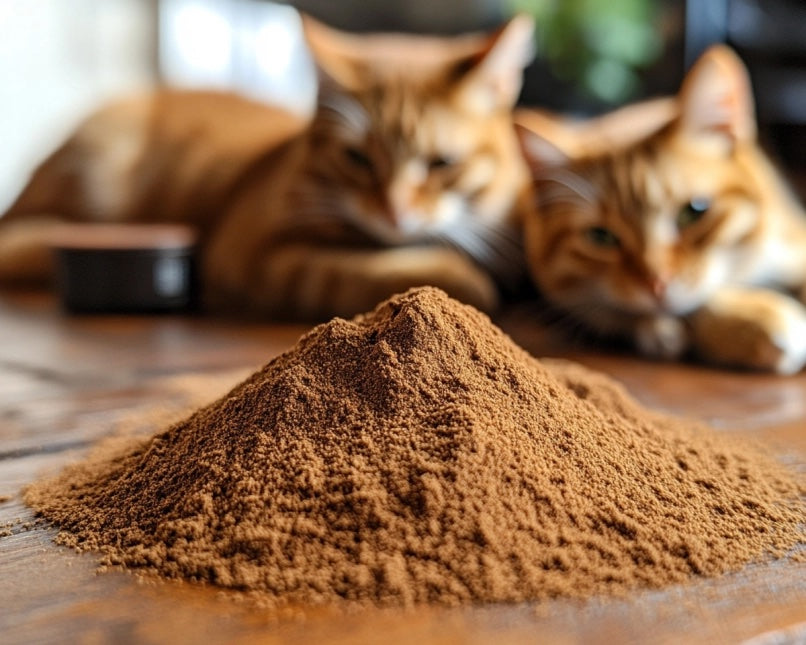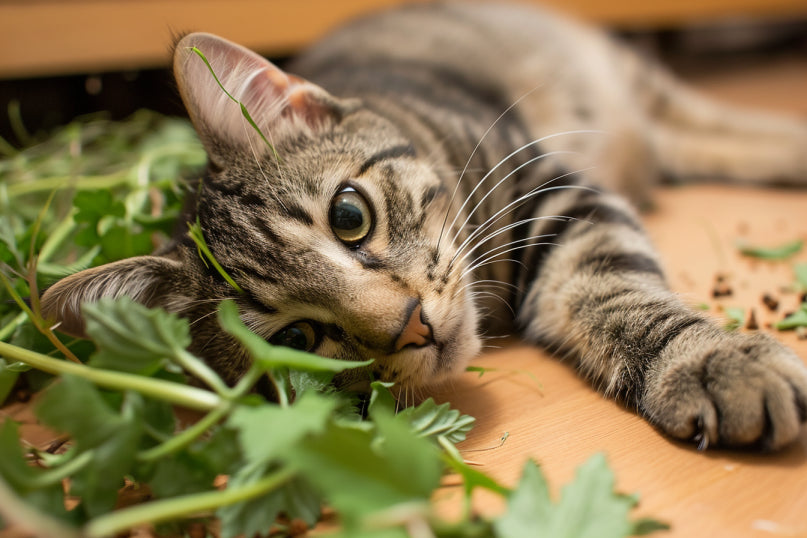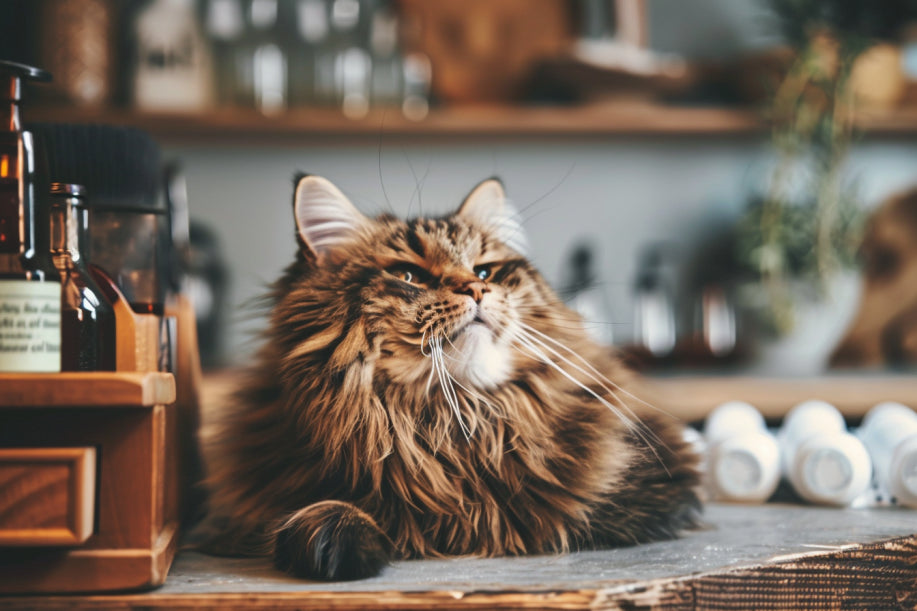
A cup of chamomile tea might lower your blood sugar, boost your immune system, and help your wounds heal faster. But is it safe to have chamomile flowers, chamomile hydrosol, chamomile oil, or chamomile tea around your cat?
It depends. There are two primary types of chamomile:
- Roman, or English, chamomile (Chamaemelum nobile)
- German chamomile (Matricaria recutita)
While they both look like miniature daisies, Roman chamomile is toxic to cats. But German chamomile is safe for cats in small doses over a short time.

We spoke with Dr. Iram Sharma, a full-time veterinarian and feline welfare expert at Happy Whisker, to find out what forms of German chamomile are safest for your cat.
Table of Contents
- What is German chamomile?
- Health Benefits of Chamomile for Cats
- Are chamomile plants safe for cats?
- Is chamomile oil safe for cats?
- Is chamomile hydrosol safe for cats?
- Is chamomile tea safe for cats?
- Can German chamomile interact with prescription and/or over-the-counter medications?
- What are the risks of giving cats chamomile?
- Can cats overdose on chamomile?
- How To Store German Chamomile
- German Chamomile Plant Profile
What is German chamomile?

German chamomile is a self-sowing annual with small, white petals and a bright, golden yellow center. The herb is native to eastern and southern Europe, western Asia, and northern Africa.
A relative of the pineapple weed, German chamomile grows in dumps, meadows, and fields. It grows 12-24 inches tall (31-61 centimeters) and 10-12 inches wide (25-30 centimeters).
German chamomile smells like sweet straw. It attracts bees, ladybugs, butterflies, and hoverflies. It is also called the "plant's physician" because it helps neglected or sick garden plants thrive.
Health Benefits of Chamomile for Cats
There is limited research on how chamomile affects cats.
Anecdotally, chamomile is a mild tranquilizer and sleep aid.
It is also recommended as a natural dewormer, especially for roundworms and whipworms. It is safer than other herbal cat dewormers like black walnut and wormwood.
Chamomile is also said to prevent inflammation and help heal open wounds by killing bacteria.
Are chamomile plants safe for cats?

While chamomile promotes relaxation and reduces stress, it is not good for your cat to eat fresh or dried chamomile flowers, leaves, stems, roots, or pollen.
German chamomile plants are toxic to cats because they contain anthemic acid, bisabolol, chamazulene, tannic acid, and volatile oil. “Cats can experience appetite loss, diarrhea, vomiting, or skin inflammation if they eat chamomile,” Sharma says.
Is chamomile oil safe for cats?
German chamomile oil smells stronger than fresh or dried chamomile plants. Even a few drops of it are dangerous for cats with asthma or other breathing problems.
Your cat's sense of smell is 14 times better than yours. So it is also difficult to tell how much German chamomile oil will overwhelm her.
Pure chamomile essential oil can cause chemical burns, kidney/liver damage, and liver failure. That's because the blue-colored essential oil contains concentrated forms of bisabolol and chamazulene.
While your cat's skin quickly absorbs German chamomile oil, her liver does not have UDP-glucuronosyltransferase (UGT) enzymes. That means it cannot break down the active ingredients in German chamomile oil.
German chamomile oil should only have two drops of essential oil per three tablespoons (approx. 890 drops) of carrier oil. "It is always best to dilute the oil with water," Sharma says. She suggests using an essential oil diffuser in an open area, so your cat can flee to another room.
Is chamomile hydrosol safe for cats?
Chamomile hydrosol is made by simmering essential oil or flowers in a pot of water. At 212°F, the water boils and turns into steam. When it condenses back into water, it becomes hydrosol (also known as hydrolat or floral water). Chamomile hydrosol has 10 drops of oil per 34 ounces (1 liter) of hydrosol, says the National Association for Holistic Aromatherapy.
“Chamomile hydrosol is safe for cats but only for external use,” Dr. Sharma adds. The apple-scented floral water is an excellent alternative to chamomile essential oil. Chamomile hydrosol can help untangle your cat’s anxiety, but it should never be added to her food or water bowl.
Is chamomile tea safe for cats?
If your kitty has frayed nerves or an upset stomach, you can give her chamomile tea.
Dr. Sharma recommends giving your cat 2-3 drops a day. Mix the chamomile tea directly into her food or water. Or put the drops of chamomile tea directly into her mouth. Never use hot chamomile tea. Let it cool down for at least 30 minutes.
"Chamomile tea bags can be used to calm your cat’s irritated skin,” Dr. Sharma says. “You can put used tea bags on her skin, or even on her eyes if she suffers from conjunctivitis (pink eye) or dry eyes.”
Can German chamomile interact with prescription and/or over-the-counter medications?
German chamomile can interfere with blood thinners, sedatives, or non-steroidal anti-inflammatory medications (NSAIDs) like Robenacoxib.
It can also interact with herbal supplements like catnip, Ginkgo biloba, kava, saw palmetto, St. John's wort, and valerian root.
Tell your vet about any dietary or herbal supplements your cat is taking.
What are the risks of giving cats chamomile?

“There aren’t many studies that have been done on how chamomile affects cats. Any records about risks and possible advantages are limited,” Dr. Sharma says. “Felines tend to have sensitive stomachs and can be particularly sensitive to the intake of chamomile.”
Chamomile should not be given to pregnant cats because it might cause miscarriage. If your cat is allergic to plants in the daisy family like ragweed, chamomile can cause allergic shock.
Chamomile also contains a mild blood thinner called coumarin. It can cause your cat to bruise or bleed easily.
Chamomile can also interact with anesthesia for surgery. Other possible disadvantages include skin irritation, vomiting, diarrhea, and appetite loss.
Can cats overdose on chamomile?
German chamomile is safe in small amounts. If your cat eats too many German chamomile stems, leaves, petals, or roots, it can cause chamomile poisoning.
The symptoms of chamomile poisoning include:
- Vomiting
- Severe diarrhea
- Upset Stomach
- Irritation of the eyes, nose, mouth, windpipe, lungs, stomach, intestines, and/or bladder
- Skin rash (Contact dermatitis)
- Decreased appetite
- A rare but severe allergic reaction (anaphylactic shock)
- Long-term use can cause bleeding and bruising
If you suspect your cat has chamomile plant poisoning, take her to your vet as soon as possible.
How To Store German Chamomile

From dried chamomile flowers to "bed-time" chamomile tea, here is how to store this ancient medicinal herb.
 Store dried chamomile flowers in an airtight glass or metal container for up to 12 months. Keep them out of direct sunlight and away from heat and humidity.
Store dried chamomile flowers in an airtight glass or metal container for up to 12 months. Keep them out of direct sunlight and away from heat and humidity.
 Frozen chamomile flowers have a 6-month shelf life. Store them in a rigid, plastic container or a glass baking dish with an airtight lid.
Frozen chamomile flowers have a 6-month shelf life. Store them in a rigid, plastic container or a glass baking dish with an airtight lid.

 If brewed chamomile tea is stored in an airtight glass container or pitcher, it can last up to 4 days in the fridge and up to 6 months in the freezer.
If brewed chamomile tea is stored in an airtight glass container or pitcher, it can last up to 4 days in the fridge and up to 6 months in the freezer.

 Chamomile oil has a shelf-life of 5 years. It should be stored in a dark-colored bottle (i.e., amber, dark blue, green, violet, or black) to protect it from all light sources.
Chamomile oil has a shelf-life of 5 years. It should be stored in a dark-colored bottle (i.e., amber, dark blue, green, violet, or black) to protect it from all light sources.
German Chamomile Plant Profile
German Chamomile |
|
 |
|
|
Scientific Name |
Matricaria recutita |
|
Nicknames |
Manzanilla, wild chamomile, blue chamomile, sweet false chamomile, Hungarian chamomile, scented mayweed, plant’s physician, and water of youth |
|
Comes from |
Eastern and southern Europe, western Asia, northern Africa |
|
Plant type |
Annual herb |
|
Advantages |
🦋 Attracts butterflies 🐞 Attracts ladybugs 🪰Attracts hoverflies 🐝 Bee-friendly
 Deer-resistant Deer-resistant
✅ Fragrant flowers and leaves ✅ Good for dried and cut flowers |
|
Hardiness Zone |
|
|
Sunlight |
☀️ Full sun ⛅ Partial shade |
|
Water Tolerance |
💧Low-Water |
|
Mature Height |
12-24" tall (31-61 cm) |
|
Mature Spread |
10"-12" wide (25-30 cm) |
|
Bloom Time |
🌸Spring 🌊Summer |


